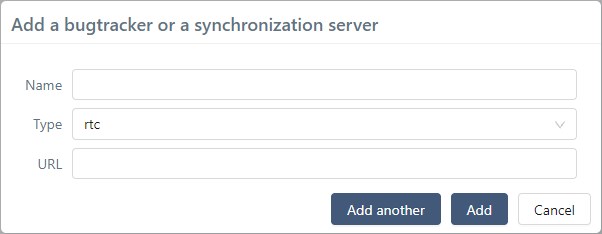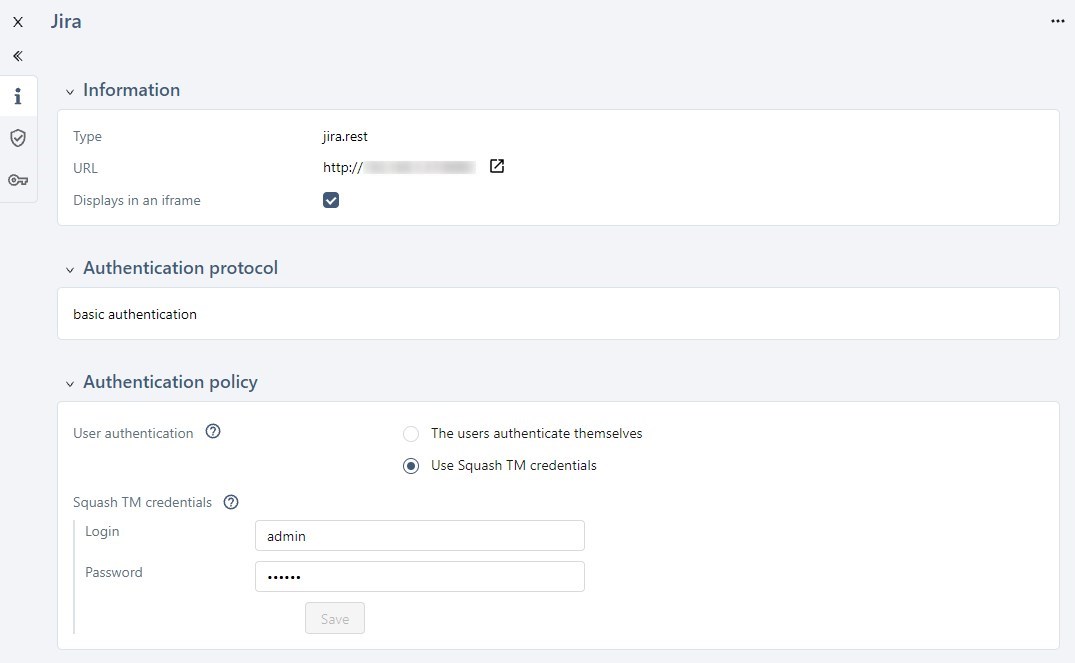Manage Bugtrackers and Synchronization Servers
Bugtrackers vs Synchronization Servers
In Squash TM, there are bugtracking plugins and synchronization plugins, which both differ from one another.
Bugtracking plugins are used to report issues from Squash TM to third-party tools such as bugtrackers.
Synchronization plugins are used to synchronize issues from third-party tools dedicated to IT project tracking to Squash TM.
Here is the list of third-party tools that can be interfaced with Squash TM:
| Plugin Name | Category | Type in the Servers workspace | Third-party Tools |
|---|---|---|---|
| Integrated in the core of Squash TM | Bugtracking | mantis | Mantis |
| Bugzilla Bugtracker | Bugtracking | bugzilla | Bugzilla |
| GitLab Bugtracker | Bugtracking | gitlab.bugtracker | GitLab |
| Jira Bugtracker Server et Data Center | Bugtracking | jira.rest | Jira Server, Jira Data Center |
| Jira Bugtracker Cloud | Bugtracking | jira.cloud | Jira Cloud |
| Xsquash4jira | Synchronization | jira.xsquash | Jira Server, Jira Data Center, Jira Cloud |
| Jira Automation Workflow | Synchronization | jira.rest ou jira.cloud | Jira Server, Jira Data Center, Jira Cloud |
| Redmine Bugtracker | Bugtracking | redmine3.rest | Redmine |
| Redmine Requirements | Synchronization | redmine3.rest | Redmine |
| Azure DevOps Bugtracker | Bugtracking | azuredevops.bugtracker | Azure DevOps |
| RTC Bugtracker | Bugtracking | rtc | Rational Team Concert |
| Tuleap Bugtracker | Bugtracking | tuleap | Tuleap |
Learn More
Apart from Mantis which is natively integrated in the core of Squash TM, you have to install the plugin(s) corresponding to the tool you want to use to access these bugtracking and/or synchronization features.
To learn more about these plugins, please visit these pages: Squash TM Plugins, Install Squash TM Plugins.
Add, Modify, and Delete a Bugtracker and a Synchronization Server
You can manage bugtrackers and synchronization servers from the Administration workspace, in "Servers" submenu, via the Bugtrackers and synchronization servers anchor  .
.
From the Manage bugtrackers and synchronization servers table, you can add ![]() or delete
or delete  one or multiple servers. You can also delete a bugtracker or synchronization server from their consultation page by clicking on the button [...].
one or multiple servers. You can also delete a bugtracker or synchronization server from their consultation page by clicking on the button [...].

When you create a bugtracker or synchronization server, you must enter its name (unrestricted), choose the type of server it is in the drop-down list, and enter the URL of the third-party tool. The URL must be as short as possible because it is used as a base for every API request used by Squash TM to communicate with the third-party tool. All these fields are mandatory.

By clicking on its row number (#) or name, the server's consultation page appears so you can modify it. The anchor bar enables you to navigate between the different blocks.

Warning
When you delete a bugtracking server, it is automatically deleted from the project with which it was associated. The value "Bugtracker step" appears on the project's consultation page.
All the associations with issues in the "Known Issues" blocks are also deleted.
Configure a Bugtracker or Synchronization Server
To get a bugtracker to accept to exchange information with Squash TM, you must identify Squash TM. By managing authentications, you can decide how users, or Squash TM will authenticate themselves on the server. The Manage authentications page has two blocks:
- The "Authentication protocol" block that defines the security protocol used to authentify the connection;
- The "Authentication policy" that determines how users and/or Squash TM authenticate themselves.
Authentication Protocol
The "Authentication protocol" block enables you to define the authentication protocol. The protocols supported by Squash TM are Basic Authentication, 0Auth 1a (only for Jira connectors), and Token Authentication. The protocols suggested during the configuration depend on your type of bugtracker.
Focus
When you change the authentication protcol, the change immediately applies. The previous configuration becomes obsolete and is deleted from the server. However, the information remains on the page as long as the page isn't closed or refreshed: if the protocol is accidentally modified, you can restore the previous protocol and save the configuration again.
Basic Authentication
Basic Authentication is the default protocol. The authentication is based on the user's login and password input. It is supported by all servers. It does not require any additional configuration. Using Basic Authentication is only secured when it is used with SSL/TLS (https).
OAuth 1a
As of now, this protocol is only used by Jira connectors. To use it, you must configure the URLs involved in token exchanges and methods for signing requests. You must complete the token and token secret fields in the "Authentication policy" block.
Learn More
To learn more about how to configure the 0Auth 1a protocol, please read this part Configure the 0Auth 1a Authentication Protocol.
Token Authentication
As of now, this protocol is only used by GitLab. This authentication is based on the user entering a token in a third-party tool, and does not require any further configuration.
Authentication Policy
The "Authentication policy" block enables you to choose how users can authenticate on the bugtracker or synchronization server.
![]()
-
Users authenticate themselves: Every user must authenticate themselves to the third-party tool. The login procedure varies depending on the chosen protocol. For a Basic Authentication, the user must enter their login and password to connect to the third-party tool in Squash TM. For 0Auth 1a, they must authenticate themselves directly in the third-party tool in a separate window.
-
Use Squash TM credentials: users no longer need to authenticate themselves. The server automatically uses the third-party credentials entered in the field "Squash TM credentials". No matter the user logged into Squash TM, the data is transmitted to the third-party tool thanks to the user credentials entered in that block.
Info
We recommend the option "Users authenticate themselves" to configure bugtrackers. Thus, the user name is entered as the issue reporter, instead of a common user. This enables you to trace the exchanges between Squash TM and the third-party tool.
You should use the option "Use Squash TM credentials" when configuring a synchronization server, especially for Xsquash4Jira and the Jira Automation Workflow plugin.
You only have to complete the "Squash TM credentials" field when the option "Use Squash TM credentials" is checked.
For the fields to be successfully saved:
- The third-party tool must be reachable;
- The credentials to connect to the third-party tool must be the right ones;
- The account associated with these credentials must have the necessary permissions in the third-party tool;
- The configuration of the server must be done correctly.
Focus
To connect to Jira Cloud, you need an API Token instead of a usual password. In the "Login" field, enter your user email; in the "Password" field, enter the API token generated for the account on Jira Cloud. To see the procedure you must follow to generate a token in detail, please visit this page: Jira Technical Account.
Focus
Azure DevOps needs a API Token instead of a password to authenticate, although the Basic Authentication protocol is used. In the "Login" field, enter your Azure DevOps organization name, and in the "Password" field, enter the personal API token generated for the user on Azure DevOps. "Read & Write" clearances on Work Items are enough. The procedure to generate a personal API token is detailed on this page: Use personal access tokens to authenticate.
Info
Squash TM keeps some information regarding authentication in its database. This information includes the protocol configuration, the Squash TM app credentials, and the 0Auth user tokens if need be. Users personal logins/passwords (Basic Authentication) are encrypted and saved in the database.